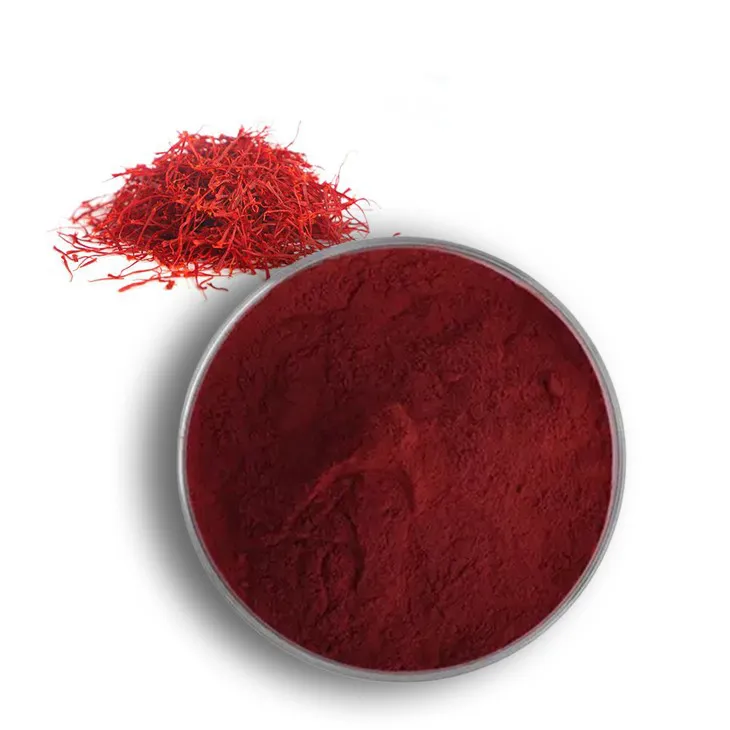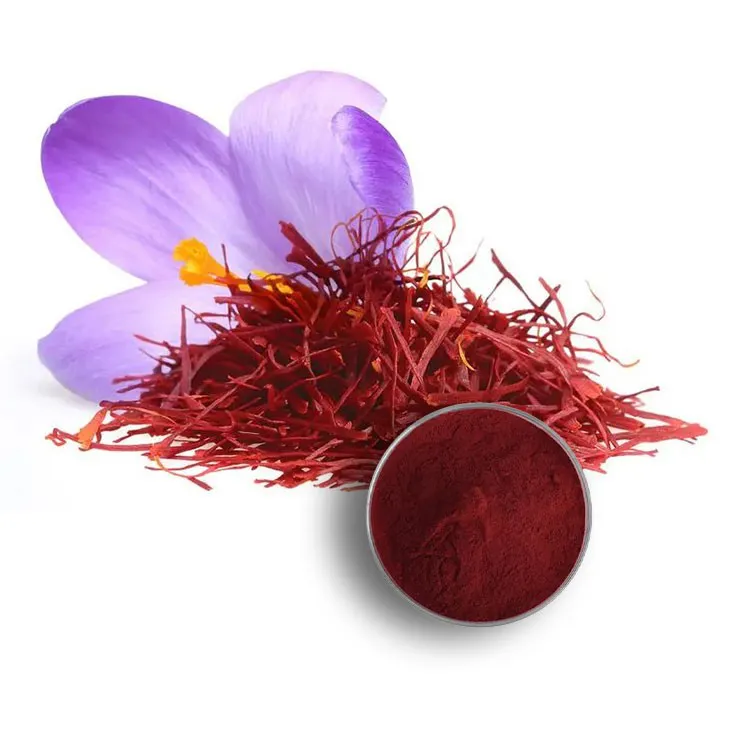- 0086-571-85302990
- sales@greenskybio.com
The process of extracting crocin from saffron extract powder.
2024-11-27

1. Introduction
Crocin extraction from Saffron Extract Powder is a crucial procedure in the realm of natural product research. Saffron, a precious and well - known spice, has been used for centuries not only in cooking but also in traditional medicine. Saffron Extract Powder, as the starting material for crocin extraction, contains a complex mixture of components. Understanding the extraction process of crocin is of great significance as crocin itself has a wide range of potential applications, especially in the pharmaceutical industry due to its antioxidant and anti - inflammatory properties.

2. Analysis of Saffron Extract Powder Composition
2.1 Importance of Composition Analysis
Before starting the extraction process, it is essential to analyze the composition of the saffron extract powder. This analysis provides valuable information about the types and amounts of different compounds present in the powder. It helps in determining the most suitable extraction conditions, such as the choice of solvent, extraction temperature, and time. For example, if the powder contains a high amount of certain lipids, it may affect the solubility of crocin during extraction, and appropriate measures need to be taken to ensure efficient extraction.
2.2 Analytical TechniquesThere are several analytical techniques available for analyzing the composition of saffron extract powder. Chromatographic techniques, such as thin - layer chromatography (TLC) and high - performance liquid chromatography (HPLC), are commonly used. TLC can provide a quick and relatively simple way to separate and identify different components in the powder. HPLC, on the other hand, offers a more accurate and detailed analysis, allowing for the quantification of individual compounds. Spectroscopic techniques, like ultraviolet - visible spectroscopy (UV - Vis) and infrared spectroscopy (IR), can also be used to study the functional groups present in the components of the powder, providing additional information about their chemical structures.

3. Solvent Extraction
3.1 Choice of Solvent
Ethanol is a frequently used solvent for crocin extraction from saffron extract powder. The reason for this choice is that ethanol can effectively dissolve crocin while minimizing the extraction of unwanted substances. Ethanol has a suitable polarity that allows it to interact with crocin molecules, which are relatively polar, and separate them from other components in the powder. Other solvents, such as water and methanol, may also be considered, but they may have some limitations. For example, water may extract too many water - soluble impurities, and methanol may be more toxic and less selective in some cases.
3.2 Solvent - to - Powder RatioThe ratio of solvent to saffron extract powder is an important parameter in the extraction process. A higher solvent - to - powder ratio generally results in a more complete extraction of crocin. However, using an excessive amount of solvent may also increase the cost and the volume of the extract, which may require more time and energy for subsequent concentration steps. A typical solvent - to - powder ratio may range from 5:1 to 20:1, depending on the specific characteristics of the powder and the desired extraction efficiency.
3.3 Influence of TemperatureTemperature plays a significant role in solvent extraction. Increasing the temperature can often increase the extraction rate of crocin. This is because higher temperatures can enhance the solubility of crocin in the solvent and accelerate the mass transfer process between the powder and the solvent. However, it is crucial to note that higher temperatures could also lead to the degradation of crocin or the extraction of other components. Crocin is a relatively heat - sensitive compound, and excessive heat may cause it to break down into smaller, less active molecules. Therefore, a balance needs to be struck between extraction rate and the preservation of crocin's integrity. The optimal temperature for crocin extraction using ethanol may range from 40 - 60°C.
3.4 Influence of TimeThe extraction time also affects the extraction efficiency. Longer extraction times generally allow for more complete extraction of crocin. However, similar to the effect of temperature, overly long extraction times may also lead to the degradation of crocin or the extraction of other unwanted substances. In addition, longer extraction times may reduce the productivity of the extraction process. A typical extraction time may range from 1 - 6 hours, depending on the specific extraction conditions such as temperature, solvent - to - powder ratio, and the nature of the saffron extract powder.

4. Filtration
After the solvent extraction step, filtration is carried out to remove solid residues. Filtration is an important step as it helps to purify the extract and separate it from any undissolved particles in the extract. There are several types of filtration methods that can be used, such as gravity filtration, vacuum filtration, and membrane filtration.
4.1 Gravity Filtration
Gravity filtration is a simple and commonly used method. It involves passing the extract through a filter paper placed in a funnel under the influence of gravity. This method is suitable for removing relatively large solid particles. However, it may be relatively slow and may not be very effective for removing very fine particles.
4.2 Vacuum FiltrationVacuum filtration is a more efficient method compared to gravity filtration. In this method, a vacuum is applied to the filtration system, which speeds up the filtration process by increasing the pressure difference across the filter. Vacuum filtration can effectively remove both large and small solid particles, resulting in a cleaner extract. However, it requires more complex equipment, such as a vacuum pump and a filtration flask.
4.3 Membrane FiltrationMembrane filtration is a highly selective filtration method. It uses a membrane with a specific pore size to separate particles based on their size. For example, microfiltration membranes can be used to remove small solid particles and some macromolecules from the extract. Ultrafiltration membranes can further separate smaller molecules based on their molecular weight. Membrane filtration can provide a high - level of purification, but it may be more expensive and require more careful handling of the membranes.
5. Concentration of the Extract
After filtration, the next step is to concentrate the extract. Concentration is necessary to increase the concentration of crocin in the extract and reduce the volume of the solvent. There are several methods for concentrating the extract, such as evaporation and lyophilization.
5.1 Evaporation
Evaporation is a common method for concentrating the extract. It involves heating the extract under reduced pressure or at normal pressure to vaporize the solvent. Rotary evaporators are often used for this purpose. By rotating the flask containing the extract, a large surface area is exposed to the heat source, which accelerates the evaporation process. However, care must be taken during evaporation to avoid overheating the extract, which could lead to the degradation of crocin. The evaporation temperature and pressure need to be carefully controlled to ensure the quality of the concentrated extract.
5.2 LyophilizationLyophilization, also known as freeze - drying, is another method for concentrating the extract. In this method, the extract is first frozen and then the solvent is removed by sublimation under reduced pressure. Lyophilization has the advantage of minimizing the degradation of heat - sensitive compounds like crocin. It also results in a dry powder form of the extract, which is more stable for storage and transportation. However, lyophilization is a more expensive and time - consuming process compared to evaporation.
6. Separation and Purification of Crocin
To obtain high - purity crocin, advanced separation techniques are often required. One of the most commonly used techniques is high - performance liquid chromatography (HPLC).
6.1 High - Performance Liquid Chromatography (HPLC)
HPLC is a powerful analytical and separation technique. In the context of crocin extraction, HPLC can be used to separate crocin from other components in the extract based on their different chemical properties, such as polarity and molecular size. The HPLC system consists of a pump, an injector, a column, and a detector. The extract is injected into the HPLC system, and the components are separated as they pass through the column. The detector then measures the amount of each component, allowing for the isolation and quantification of crocin. Different types of columns and mobile phases can be selected depending on the specific requirements of the separation. For example, a reversed - phase column with a polar mobile phase may be used for the separation of crocin.
7. Conclusion
The extraction of crocin from saffron extract powder is a multi - step process that requires careful consideration of various factors, including the analysis of powder composition, solvent extraction conditions, filtration methods, concentration techniques, and separation and purification methods. Each step plays a crucial role in obtaining high - quality and high - purity crocin. Crocin, with its antioxidant and anti - inflammatory properties, has high value in various sectors, especially in the pharmaceutical industry. Continued research in this area is expected to further optimize the extraction process and expand the applications of crocin.
FAQ:
What are the main factors affecting the extraction of crocin from saffron extract powder?
The main factors include the choice of solvent, temperature, and time. Ethanol is a commonly used solvent. Temperature can influence the extraction rate as well as the stability of crocin, and extraction time also has an impact on the extraction process.
Why is ethanol a good solvent choice for extracting crocin from saffron extract powder?
Ethanol can effectively dissolve crocin while minimizing the extraction of unwanted substances, which helps in obtaining a relatively pure crocin extract.
What is the purpose of filtration after the extraction of crocin?
The purpose of filtration is to remove solid residues left from the extraction process, which helps to purify the extract before further processing.
How can high - purity crocin be obtained from the saffron extract?
After the initial extraction, filtration, and concentration, advanced separation techniques such as high - performance liquid chromatography (HPLC) can be used to obtain high - purity crocin.
What are the applications of crocin obtained from saffron extract powder?
Crocin has high value in various sectors, especially in pharmaceuticals due to its antioxidant and anti - inflammatory properties.
Related literature
- Crocin: A Review of Its Properties, Extraction, and Applications"
- "Advances in Saffron Crocin Extraction and Analysis"
- "The Role of Crocin in Natural Product - Based Pharmacology"
- ▶ Hesperidin
- ▶ citrus bioflavonoids
- ▶ plant extract
- ▶ lycopene
- ▶ Diosmin
- ▶ Grape seed extract
- ▶ Sea buckthorn Juice Powder
- ▶ Beetroot powder
- ▶ Hops Extract
- ▶ Artichoke Extract
- ▶ Reishi mushroom extract
- ▶ Astaxanthin
- ▶ Green Tea Extract
- ▶ Curcumin Extract
- ▶ Horse Chestnut Extract
- ▶ Other Problems
- ▶ Boswellia Serrata Extract
- ▶ Resveratrol Extract
- ▶ Marigold Extract
- ▶ Grape Leaf Extract
- ▶ blog3
- ▶ blog4
-
D - Mannose Manufacturer
2024-11-27
-
The best organic chia seed powder.
2024-11-27
-
Garcinia Cambogia Extract
2024-11-27
-
Tongkat Ali Extract
2024-11-27
-
Clove Powder
2024-11-27
-
Golden Seal Extract
2024-11-27
-
Andrographis Paniculata Extract Powder
2024-11-27
-
Oat Straw Extract Powder
2024-11-27
-
Quercetin
2024-11-27
-
Bayberry Extract
2024-11-27
-
Epimedium extract powder
2024-11-27
-
Acerola Juice Powder
2024-11-27





















